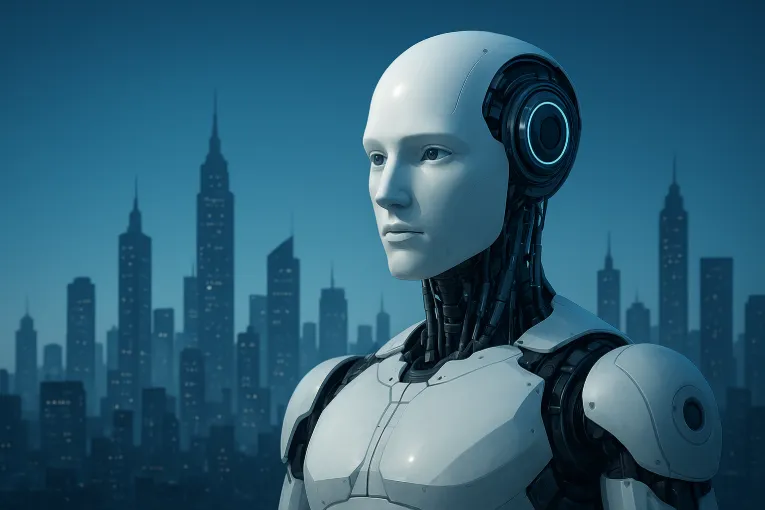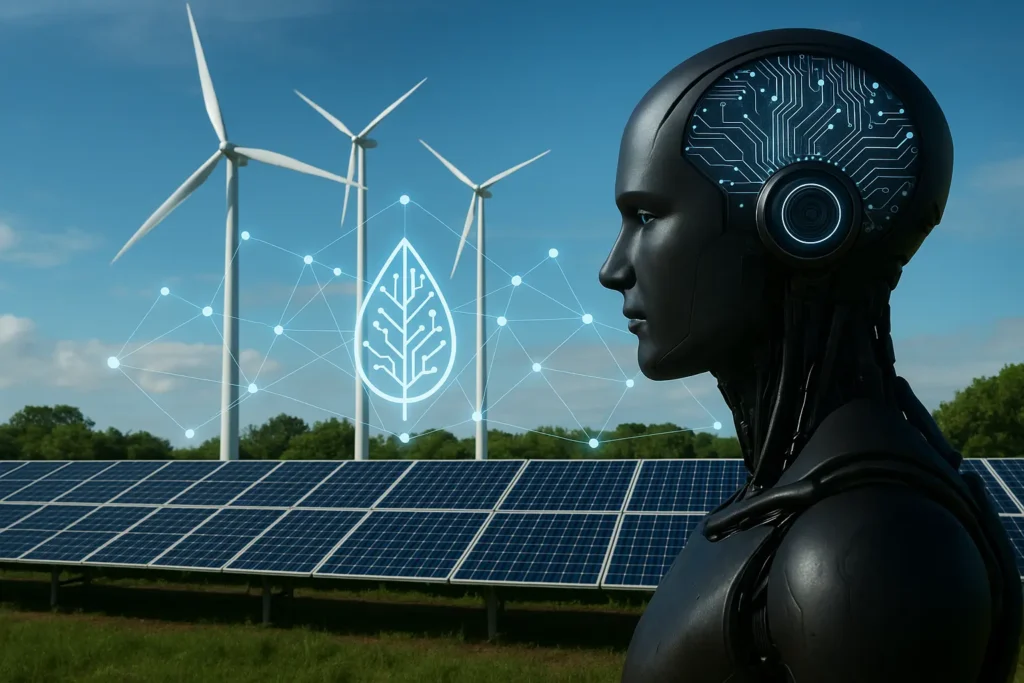Artificial intelligence (AI) is the field of computer science that focuses on building machines capable of performing tasks that normally require human intelligence. In simple words, it means developing systems that can make decisions independently without detailed instructions, learn from data, and adapt to changing circumstances.
AI is important because it helps us tackle complex problems more efficiently. In fields such as healthcare, education, business, and everyday life, it enhances problem-solving skills by offering more intelligent solutions, decreasing human error, and saving time. AI is influencing a future where technology can handle repetitive tasks.

Types of Artificial Intelligence by Capability
Artificial Narrow Intelligence
Artificial Narrow Intelligence (ANI) refers to AI systems designed to perform a single, clearly defined task with high accuracy, such as fraud detection in banking, product recommendations in e-commerce, or voice assistance through tools like Siri and Alexa.
Since ANI is restricted to its training data and algorithms, it is unable to apply its knowledge to unrelated problems. Due to this specialization, it is often referred to as weak AI or task-specific intelligence; yet, it remains the most widely used and practical form of AI in industries today.
Artificial General Intelligence
Artificial General Intelligence (AGI) is the concept of machines that can perform any intellectual task at a human level, surpassing the capabilities of narrow AI systems. Its features include problem-solving across domains, transfer learning, reasoning, adaptability, and decision-making closer to the human brain.
Artificial general intelligence (AGI) is still being studied, and efforts are being made to ensure its safe development in the fields of large language models, reinforcement learning, and AI governance.
Artificial Superintelligence
A hypothetical stage of artificial intelligence known as artificial superintelligence (ASI) would outsmart humans in every way, from problem-solving and creativity to action and emotional intelligence.
Its features would include the ability to analyze data at unimaginable scales, improve itself autonomously, and achieve insights far beyond the limits of the human brain. ASI remains purely theoretical, and current research focuses more on preventing potential risks, addressing AI ethics, and exploring AI governance to ensure safety if such systems ever emerge.
Types of Artificial Intelligence by Function
Reactive Machines
Reactive Machines are the earliest and most limited type of AI, built to respond only to current inputs without storing data or learning from experiences. They follow fixed rules to deliver consistent results, which is why they can handle tasks such as playing chess or filtering unwanted emails quickly and accurately.
They work well for repetitive duties, but since they cannot adapt or learn from new information, their use is limited compared to more advanced AI systems.
Limited Memory
A type of artificial intelligence that improves its decisions by temporarily storing and learning from past data. These systems use recent information, such as sensor readings, user behavior, or transaction history, to guide their actions.
This is how fraud-detection tools identify odd spending patterns, recommendation engines make product ideas based on browsing activity, and self-driving cars track recent movements to navigate safely.
Theory of Mind
This type of AI focuses on interpreting human emotions, intentions, and beliefs to enable more natural and human-like interactions. Applications such as empathy-based virtual assistants, social robots for education or elder care, adaptive tutoring programs, emotional healthcare companions, negotiation tools, and tone-adjustable customer service bots are being investigated.
AI requires advancements in emotion recognition, natural language processing, and human–computer interaction. There are a few lab prototypes, but research is still ongoing to develop dependable, large-scale systems.
Self-Aware AI
Self-Aware AI is a theoretical stage in which systems possess an internal awareness of their own existence in addition to understanding the outside world. In that scenario, the AI would acknowledge itself as a unique being that might be able to think back on its objectives, conditions, and experiences.
Although there are currently no empirical examples, researchers examine minimalist models of artificial consciousness to explore the possibility that self-awareness could emerge from dynamic self-models and layered cognitive architectures.
Types of Artificial Intelligence by Technology and Application
Machine Learning (ML)
Machine learning (ML) is a type of artificial intelligence that enables computers to learn from data, recognize patterns, and make predictions when exposed to new information. This eliminates the need for predetermined instructions for every scenario, enabling computer systems to identify trends and forecast outcomes.
These systems automatically enhance their performance when exposed to bigger and more diverse datasets, opening up a new class of applications ranging from automated fraud detection to personalized product recommendations.
It serves as an intelligent layer that enhances existing services in healthcare diagnostics, financial systems, personal devices, and transportation, while also driving the development of new technologies.
Machine learning continues to demonstrate the value of these systems by improving their personalization, efficiency, and dependability. Additionally, as data volume increases, its function will only deepen, enabling us to better comprehend the world and address challenging issues.

Deep Learning (DL)
Deep learning is a subfield of machine learning that uses multi-layered artificial neural networks, which are modeled after the connections between neurons in the human brain. These networks are referred to as “deep” because of their numerous layers, which allow them to process and learn from vast amounts of complex, unstructured data.
Deep learning is therefore highly effective in advanced applications such as image recognition, natural language processing, and autonomous vehicle technology.
Natural Language Processing (NLP)
Natural Language Processing (NLP) is a branch of artificial intelligence that enables computers to understand, interpret, and generate human language in a meaningful manner. It teaches algorithms to comprehend vast amounts of speech or text, derive meaning, detect shifts, and assist in making decisions.
NLP powers a wide range of standard applications, including machine translation, sentiment analysis in social media, AI-powered chatbots that improve customer service, and virtual assistants like Siri and Alexa.
Computer Vision (CV)
The branch of artificial intelligence known as computer vision enables computers to extract useful information from visual inputs such as pictures and videos. It enables machines to visually perceive, evaluate, and understand the world as humans.
Algorithms are trained on massive image datasets to detect patterns, recognize objects, and even distinguish individual people. Computer vision has a wide range of innovative real-world applications.
It is the foundation of autonomous vehicles in the automotive industry, enabling cars to recognize traffic signs, pedestrians, and other vehicles driving on roads safely. Surveillance cameras utilize computer vision to identify individuals of interest in a crowd, detect, and highlight any questionable activity.
Additionally, the technology supports the analysis of medical scans such as MRIs and X-rays, permitting the automated detection of abnormalities and helping physicians make more precise diagnoses.
In manufacturing, it powers automated quality control systems that can inspect products on an assembly line for defects with incredible speed and precision. Ultimately, computer vision is a powerful tool for automating tasks that require visual understanding, driving efficiency and safety across numerous sectors.

Robotics
Robotics is a field that merges computer science, engineering, and artificial intelligence to create machines capable of assisting or replicating human actions. Modern robots utilize sensors, actuators, control systems, and sophisticated software to perceive their environment, make informed decisions, and perform tasks efficiently.
They enhance precision, reduce mistakes, and handle tasks that are repetitive, dangerous, or require high levels of accuracy. Their applications span across manufacturing, healthcare, logistics, and everyday services.
Expert Systems
One of the earliest and most important types of artificial intelligence is expert systems, which are created to replicate the decision-making abilities of human experts in specific areas. They consist of two main components: an inference engine, which employs logical reasoning to reach conclusions, and a knowledge base, which stores facts and rules.
Expert systems, which facilitate the process of taking actions, are more transparent, accurate, and reliable than traditional software. They are beneficial at solving complicated or ambiguous problems because they can apply logical reasoning.
Expert systems are now widely used in manufacturing for product configuration and troubleshooting, in healthcare for medical diagnosis, in finance for market forecasting, and in resource management for scheduling and logistics.
Generative AI
An advanced type of artificial intelligence, known as generative AI, is designed to create original text, images, audio, video, and even code. Generative AI learns patterns from massive datasets and produces new outputs that resemble the original data without directly replicating it.
It utilizes deep learning and large neural networks, similar to diffusion models that make high-quality images from text, generative adversarial networks (GANs) that produce realistic pictures, and large language models (LLMs) that work with natural language tasks.
There are many applications for generative AI, including drug discovery, education, scientific research, software development, content creation, and individualized customer support. It plays a vital role in accelerating innovation, boosting productivity, and enabling new creative possibilities.
However, generative AI also raises concerns regarding intellectual property, bias, disinformation, and legal application. Consequently, it works best when combined with responsible governance and human oversight.
FAQs
1. What three AI solutions do businesses commonly use?
Businesses often utilize AI for various purposes, including customer service chatbots, predictive data analysis, and process automation, all aimed at enhancing efficiency and facilitating better decision-making.
2. Can AI replace humans?
Since AI lacks qualities such as creativity, empathy, and critical thinking, it is not anticipated to fully replace humans. Instead, it serves as a valuable tool that enhances human capabilities and automates tasks, fostering a productive relationship.
3. Is AI just an algorithm?
An algorithm is simply a set of instructions that artificial intelligence (AI) uses to learn and perform tasks. Unlike fixed programming for every situation, AI is a broader system that adapts and solves problems by analyzing data.
4. What are the main risks of AI?
The significant risks of AI include job displacement, privacy concerns, and the potential for algorithmic bias to lead to unfair decisions. It also presents challenges with security and autonomous weapons.
7. Will the humanities survive AI?
Yes, the humanities will continue to grow and adapt in the age of AI.
8. How should a business start using AI safely?
A business should start by identifying a single, small-scale issue that AI can resolve, as automating a single operation. After that, they should focus on ensuring the data is unbiased and clean and set precise moral standards for its application.
9. Why is AI important to the future?
AI is important because it can solve complex problems, automate repetitive tasks, and boost our ability to make better decisions. It will drive innovation and efficiency across almost every industry, from medicine to transportation.
References
The information in this article is based on insights from respected organizations in the energy field. We have reviewed content from the following sources to ensure accuracy and relevance:
- IBM.com
- Coursera.org
- Britannica.com
- Wikipedia
- VisionX
- Amazon
- Apple
- UNESCO
- Medium
- National Laboratory of Medicine

Posted by Abu Talha
With a background in science at the A-level, Abu Talha has studied subjects including physics, chemistry, mathematics, and biology. Along with his more than 1.5 years of experience in digital marketing, he is passionate about writing about electric vehicles, sustainable energy, and how emerging technologies are influencing the future.

